Turner, Oregon – Monday, May 27th, 2019
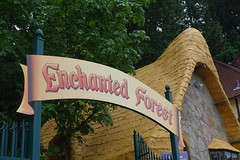 The same week I was in Oregon, Disneyland was getting ready to debut a new themed experience that was heralded for its potential to redefine what a theme park could be in terms of interactivity, “immersiveness”, and sheer scale. While I wouldn’t disagree with that assessment, such big-budget types of themed experiences always seem to push at the boundaries in the direction that everyone expects them to be pushed. Far more radical, I might argue, is a place like Enchanted Forest near Salem, Oregon, which has spent nearly 50 years quietly pushing on the boundaries of the theme park format in ways that nobody really expected, or, for that matter, was even paying attention to.
The same week I was in Oregon, Disneyland was getting ready to debut a new themed experience that was heralded for its potential to redefine what a theme park could be in terms of interactivity, “immersiveness”, and sheer scale. While I wouldn’t disagree with that assessment, such big-budget types of themed experiences always seem to push at the boundaries in the direction that everyone expects them to be pushed. Far more radical, I might argue, is a place like Enchanted Forest near Salem, Oregon, which has spent nearly 50 years quietly pushing on the boundaries of the theme park format in ways that nobody really expected, or, for that matter, was even paying attention to.
 Yes, a lot of the “theme park” fundamentals are all here in Enchanted Forest. Unlike many other amusement parks its size, Enchanted Forest is thoroughly rooted in the modern theme park tradition. There’s the collection of themed lands based on popular tropes like European fantasy or the American west, several main rides and attractions modeled after successful predecessors from southern California, and the typical assortment of live entertainment, dining, and retail to round out the program.
Yes, a lot of the “theme park” fundamentals are all here in Enchanted Forest. Unlike many other amusement parks its size, Enchanted Forest is thoroughly rooted in the modern theme park tradition. There’s the collection of themed lands based on popular tropes like European fantasy or the American west, several main rides and attractions modeled after successful predecessors from southern California, and the typical assortment of live entertainment, dining, and retail to round out the program.
But then there’s those boundary pushing aspects that it seems everyone outside of Oregon forgot to take notice of. There’s the entry sequence, foregoing a typical “Main Street” setup with concentrated shops and amenities in favor of a 20+ minute semi-linear storybook walk-though experience. There’s the hidden interactives discovered throughout the park, many of which are novel to a theme park context. There’s even innovations in attraction technology, be it the world’s first water-coaster hybrid, a trackless dark ride debuting eight years before a park in Florida or California would ever open one, or an enclosed capsule roller coaster that, 36 years later, is still a totally one-of-a-kind design. But perhaps more importantly, there’s the deep integration with the natural landscaping and topography, allowing the trees and hills to create some of the most fully-immersive themed environments ever experienced. There’s the business structure, being in the care of a single family since its opening, allowing for a close-knit owner-designer-operator model that virtually no other modern American theme park has been able to emulate much beyond the 1980’s. Or the fact the park has found a sustainable business model still charging just $13.50 for park admission in 2019, proving that a detailed and lovingly crafted theme park needn’t be a $100+ luxury reserved only for those who can afford to live near a major metropolitan area.
more importantly, there’s the deep integration with the natural landscaping and topography, allowing the trees and hills to create some of the most fully-immersive themed environments ever experienced. There’s the business structure, being in the care of a single family since its opening, allowing for a close-knit owner-designer-operator model that virtually no other modern American theme park has been able to emulate much beyond the 1980’s. Or the fact the park has found a sustainable business model still charging just $13.50 for park admission in 2019, proving that a detailed and lovingly crafted theme park needn’t be a $100+ luxury reserved only for those who can afford to live near a major metropolitan area.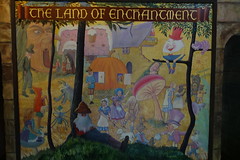
These aren’t the elements that are typically prognosticated for the “future of theme parks”, but maybe they should be part of that conversation? Currently, what’s usually meant by “boundary pushing” seems inevitably linked to “more expensive” and thus “more exclusive”, which is clearly not sustainable in the long run. Perhaps Enchanted Forest, a park that’s quite literally green everywhere, could be a better model for sustainable themed entertainment in the next century?
I arrived a few minutes after opening and already there was a queue to buy tickets. Was in within 15 minutes. The first thing that makes Enchanted Forest quite unlike other theme parks hits you as soon as you walk in. It’s quite clear from signage and the flow of the pathway which way to go…
The first thing that makes Enchanted Forest quite unlike other theme parks hits you as soon as you walk in. It’s quite clear from signage and the flow of the pathway which way to go…
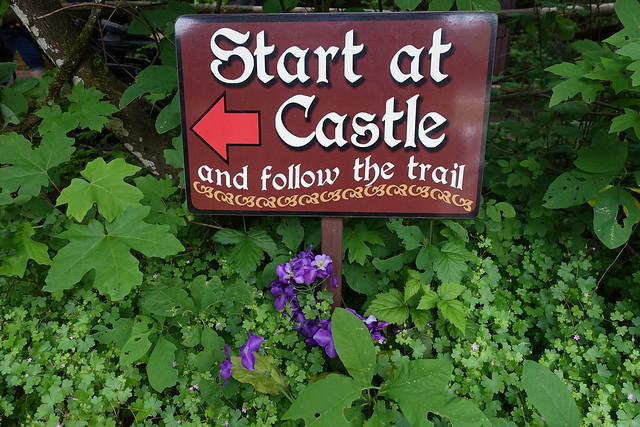 Rather than rush right into the park to start riding rides, Enchanted Forest directs everyone (or, at least, about 90-95% of guests based on my casual observations) to begin with the Storybook Lane walk-through, the park’s original attraction. It reminded me a bit of the “Oasis” entry pathway to Discovery Island at Disney’s Animal Kingdom, which I love for making the first beat purely experiential, training guests on how to explore and interact with this fantastical space… only in the case of Enchanted Forest, this first beat goes on for ten times longer! As the sign says, we begin at the castle:
Rather than rush right into the park to start riding rides, Enchanted Forest directs everyone (or, at least, about 90-95% of guests based on my casual observations) to begin with the Storybook Lane walk-through, the park’s original attraction. It reminded me a bit of the “Oasis” entry pathway to Discovery Island at Disney’s Animal Kingdom, which I love for making the first beat purely experiential, training guests on how to explore and interact with this fantastical space… only in the case of Enchanted Forest, this first beat goes on for ten times longer! As the sign says, we begin at the castle:

 A welcoming statement by the park’s creator, Roger Tofte, who opened the park in 1971 and is still running it with his family today.
A welcoming statement by the park’s creator, Roger Tofte, who opened the park in 1971 and is still running it with his family today.
 Inside there’s already several hidden passageways to explore and dioramas to discover.
Inside there’s already several hidden passageways to explore and dioramas to discover.



 Out of the castle and onward to the next stories.
Out of the castle and onward to the next stories.


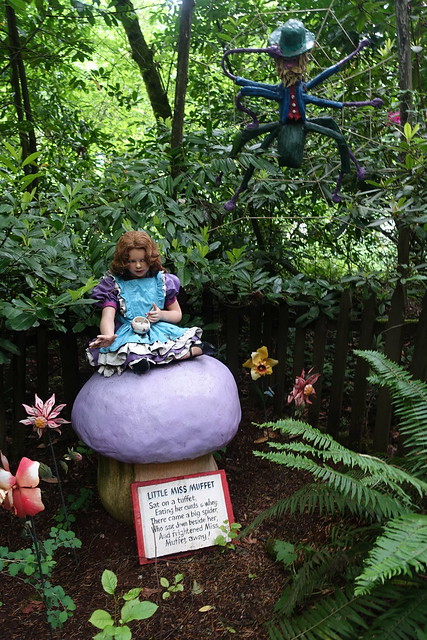 Just a short detour to check in on Hansel and Gretel…
Just a short detour to check in on Hansel and Gretel…
 It’s funny because it’s cannibalism!
It’s funny because it’s cannibalism!
 Some of the stories featured on Storybook Lane are quite simple one-scene displays, like Mary had a little lamb:
Some of the stories featured on Storybook Lane are quite simple one-scene displays, like Mary had a little lamb:
 Others are much more elaborate multi-part scenes with branching pathways to explore, like Alice in Wonderland. If you’re small enough, you can crawl down this rabbit hole and end up some 25 feet further down the main pathway on the other side. I decided to save this particular adventure for next time.
Others are much more elaborate multi-part scenes with branching pathways to explore, like Alice in Wonderland. If you’re small enough, you can crawl down this rabbit hole and end up some 25 feet further down the main pathway on the other side. I decided to save this particular adventure for next time.


 Hooray for the public domain, without which IP-based theme parks like this wouldn’t exist.
Hooray for the public domain, without which IP-based theme parks like this wouldn’t exist.
 There was even this maze to explore. Pretty basic but it still managed to trick me into several dead-ends.
There was even this maze to explore. Pretty basic but it still managed to trick me into several dead-ends.

 Jack and Jill are appropriately placed right when the pathway requires us to walk up a hill.
Jack and Jill are appropriately placed right when the pathway requires us to walk up a hill.
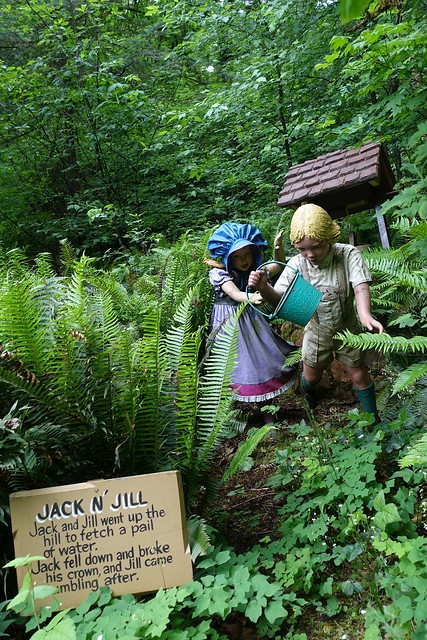
 I absolutely love how green this park is! It’s part theme park, and part state park hiking trail in a temperate rainforest. It’s incredible how dense they let the forest grow around the park; while this type of landscaping might be a “free” to add, it’s certainly not free to keep the other built elements in as pristine a condition as they are without nature taking over. If left alone for a year or two this park would be practically unrecognizable.
I absolutely love how green this park is! It’s part theme park, and part state park hiking trail in a temperate rainforest. It’s incredible how dense they let the forest grow around the park; while this type of landscaping might be a “free” to add, it’s certainly not free to keep the other built elements in as pristine a condition as they are without nature taking over. If left alone for a year or two this park would be practically unrecognizable.
 Snow White and the Seven Dwarfs first offers a couple simple dioramas to peer into.
Snow White and the Seven Dwarfs first offers a couple simple dioramas to peer into.


 But then you get to explore the dwarfs’ diamond caverns, which are unexpectedly quite long.
But then you get to explore the dwarfs’ diamond caverns, which are unexpectedly quite long.

 Although Enchanted Forest has a castle, it’s the Witch’s Head that’s perhaps its most recognizable landmark. You can enter her mouth to find a slide inside.
Although Enchanted Forest has a castle, it’s the Witch’s Head that’s perhaps its most recognizable landmark. You can enter her mouth to find a slide inside.
 Next is Goldilocks and the Three Bears. While none of the dioramas are nearly as sophisticated as, say, the Sleeping Beauty Castle walk-through at Disneyland, their handmade quality still manages to pack a lot of detail and charm. Plus… there’s a lot of them!
Next is Goldilocks and the Three Bears. While none of the dioramas are nearly as sophisticated as, say, the Sleeping Beauty Castle walk-through at Disneyland, their handmade quality still manages to pack a lot of detail and charm. Plus… there’s a lot of them!

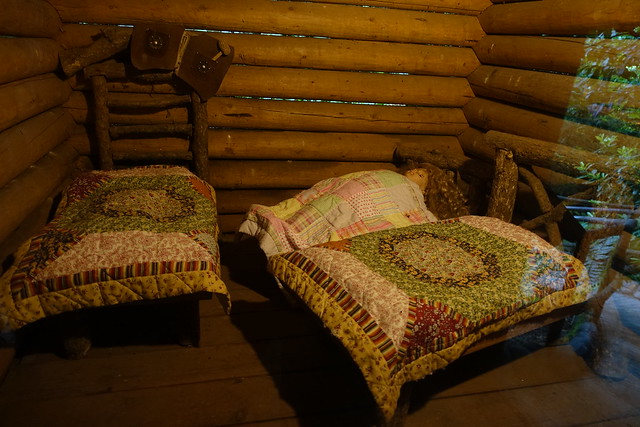 Time to visit the crooked man in his crooked house.
Time to visit the crooked man in his crooked house.
Nightmare fuel.
 Just a few more. Little Red Riding Hood…
Just a few more. Little Red Riding Hood…
 And, finally, the old lady who lived in a shoe… (with another slide!)
And, finally, the old lady who lived in a shoe… (with another slide!)
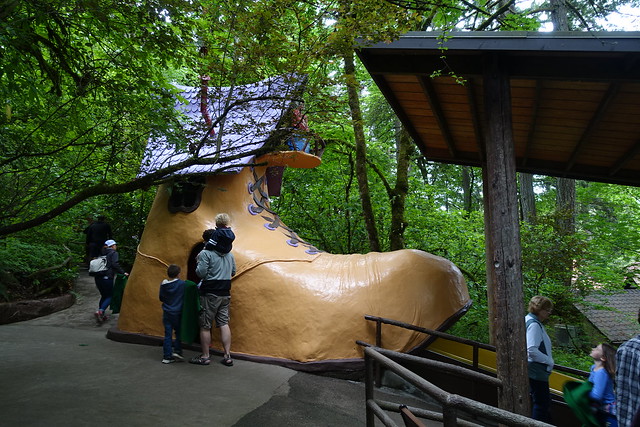 Storybook Lane serves as a charming, kitschy introduction to the theme and history of Enchanted Forest, delivering on all the fairy tales guests would hope to experience from a place named “Enchanted Forest” while communicating that this is a unique kind of theme park with different rules of play. Nevertheless, despite its fresh coat of paint, Storybook Lane still shows its age through its conceptual simplicity, not quite rising yet to the level of a “theme park”. That all promptly changes at the end of Storybook Lane when you enter the “new” portion that forms the majority of the park, beginning with Enchanted Forest’s first ride, the Ice Mountain Bobsled.
Storybook Lane serves as a charming, kitschy introduction to the theme and history of Enchanted Forest, delivering on all the fairy tales guests would hope to experience from a place named “Enchanted Forest” while communicating that this is a unique kind of theme park with different rules of play. Nevertheless, despite its fresh coat of paint, Storybook Lane still shows its age through its conceptual simplicity, not quite rising yet to the level of a “theme park”. That all promptly changes at the end of Storybook Lane when you enter the “new” portion that forms the majority of the park, beginning with Enchanted Forest’s first ride, the Ice Mountain Bobsled.
Obviously inspired by the Matterhorn Bobsleds at Disneyland, Ice Mountain Bobsled apparently began life in 1983 as something closer to an actual bobsled type experience before being lengthened and converted in 1985 into a steel coaster. The customized ride looks and feels entirely homemade, albeit by dedicated craftsmen with a lot of time to tinker to get it right. While I might have been expecting this contraption to be barely held together with duct tape, upon closer inspection during my first ride I found it appeared to be in pretty reliable working condition with trains appearing recently refurbished. And oh those trains…

You get to ride in these big padded tubs. Unlike the updated Matterhorn cars, these seats are actually quite comfy, with plenty of leg room and shock absorption materials on all sides. The closest comparison I have is to the tragically now-defunct Wild Mouse at Blackpool. There are no restraints of any kind inside the vehicle, although I suppose the big transparent hood that closes over the top of the car sort of functions like an external restraint. While it might look a bit horrifying to a seasoned coaster rider (I still remember this), it actually proved to be an ingenious design, as it allows the ride to operate free of more restrictive seat belts or lap bars, and with the hood completely restricting the reach envelope the cars are allowed to navigate through some of the tightest clearances I’ve seen since Lost Coaster of Superstition Mountain. (It also helps to speed up dispatch times.)
The first lift hill features a waterfall cascading down next to it!
Then it’s into the dark tunnel of Ice Mountain.
 The track still runs through the original bobsled trough at the beginning of the layout, emerging from the tunnel to do a high-speed out-and-back bobsled run through the woods away from guest view, skimming a few tree trunks with inches to spare.
The track still runs through the original bobsled trough at the beginning of the layout, emerging from the tunnel to do a high-speed out-and-back bobsled run through the woods away from guest view, skimming a few tree trunks with inches to spare.
There’s a midcourse brake at the end of the trough, where it then turns around to dip further down the hill, finishing the high-speed portion with a big undulating helix above the forest floor. While some of the transitions can be quite jarring, the cushy love tubs we’re sitting in keep it all in good fun.
After going on for much longer than I would have expected, we hit a second chain lift to pull us back up the hill and reconnect with the original bobsled configuration.
There’s a small hop and another close shave through a tunnel under the lift.
After a short brake run next to the transfer track, it follows the bobsled trough for a gently dipping curve back into the loading station.
I rode Ice Mountain Bobsled five times that day, grabbing POV videos from both the front seat and back.
Ice Mountain Bobsled stands atop what Enchanted Forest calls its Old World Village. This is where Enchanted Forest’s theme park credentials really shine through. Not only do the facades have a quality of thematic design that compares to many major theme parks, but the lower attendance requirements allow it to be built at a much more intimate, human scale.
Details abound as well. Animatronic figures chat with each other above the pathway.
The shopfront windows all contain a surprise. Sir Newton’s Gravity Factory contains this enormous marble machine, with a button near the window to activate it.
This window uses the curtains to conceal the triangular mirrors of an oversized spinning kaleidoscope.
 The details go much deeper than just the windows and facades. This seemingly innocuous entryway revealed an entire labyrinth of hidden discoveries within.
The details go much deeper than just the windows and facades. This seemingly innocuous entryway revealed an entire labyrinth of hidden discoveries within.
 First there’s an exhibit on Puppets of the World.
First there’s an exhibit on Puppets of the World.

 But the pathway keeps going, up stairs and around corners with several rooms splitting off. There are more dioramas like the Three Blind Mice…
But the pathway keeps going, up stairs and around corners with several rooms splitting off. There are more dioramas like the Three Blind Mice…
Pepper’s ghost illusions you can (not) touch.
Periscopes and speaking tubes. It keeps going and going… even across a bridge to the other side of the pathway.
It keeps going and going… even across a bridge to the other side of the pathway.

 On the other side, there’s a large model railroad. (Sadly out of commission today.)
On the other side, there’s a large model railroad. (Sadly out of commission today.)
 And finally, finally, FINALLY there’s the diorama of Pinocchio and Geppetto.
And finally, finally, FINALLY there’s the diorama of Pinocchio and Geppetto.
 That’s not even the only pop-in discoverable in the Old World Village. Another door takes you to a viewing platform of the Ice Mountain Bobsled, while this door promised something called the Fantasy Fountains. A 7 minute water show running every 8 minutes. Seems like a pretty good chance I’ll be able to catch it!
That’s not even the only pop-in discoverable in the Old World Village. Another door takes you to a viewing platform of the Ice Mountain Bobsled, while this door promised something called the Fantasy Fountains. A 7 minute water show running every 8 minutes. Seems like a pretty good chance I’ll be able to catch it!
 This indoor fountain and light show offers seating for the nearby dining area, and has been running since 1988, well before Disney’s World of Color or the Bellagio made fountain shows the popular thing at theme parks.
This indoor fountain and light show offers seating for the nearby dining area, and has been running since 1988, well before Disney’s World of Color or the Bellagio made fountain shows the popular thing at theme parks.
Nearby I followed the sound of Irish music to find a live performance underway by a group called Possibly Irish.
Last but not least in the Old World Village is the Challenge of Mondor, an interactive trackless dark ride.
 This is Enchanted Forest’s newest ride, opening in 2006, featuring their most detailed queue design.
This is Enchanted Forest’s newest ride, opening in 2006, featuring their most detailed queue design.


 Another first for me was getting the “preshow” spieled at me by the ride operator on my first ride.
Another first for me was getting the “preshow” spieled at me by the ride operator on my first ride.
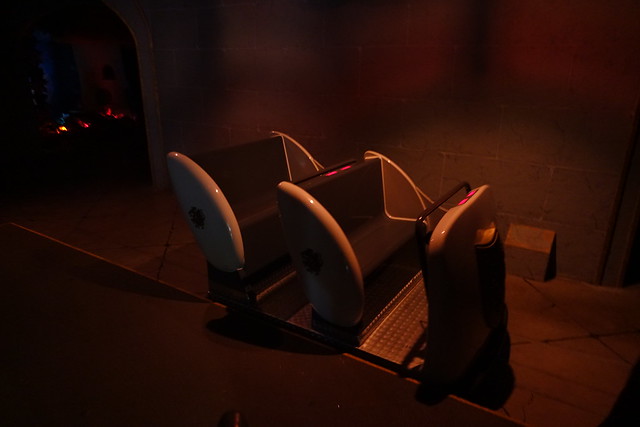 Essentially, a wizard recruits you on a mission to fight the Creatures of the Dark in order to rescue the Drumlins and return them to their homeland. Between some tangential naming and the overall setup, it’s not hard to interpret this ride as heavily inspired by the Hobbit or Lord of the Rings while avoiding Tolkien’s copyright. For a park that’s otherwise based on public domain fairy tales and nursery rhymes, it makes sense that they’d want a slightly more mature fantasy literature inspiration for their first big dark ride.
Essentially, a wizard recruits you on a mission to fight the Creatures of the Dark in order to rescue the Drumlins and return them to their homeland. Between some tangential naming and the overall setup, it’s not hard to interpret this ride as heavily inspired by the Hobbit or Lord of the Rings while avoiding Tolkien’s copyright. For a park that’s otherwise based on public domain fairy tales and nursery rhymes, it makes sense that they’d want a slightly more mature fantasy literature inspiration for their first big dark ride.
Now, let’s go rescue those Drumlins!
 First we meet the wizard, whose name is Mondor, so I guess this is his challenge.
First we meet the wizard, whose name is Mondor, so I guess this is his challenge.
 Lighting design and scenic set dressing were quite well done, considering most modern dark rides in independent parks of this size rarely exceed to a Ghost Blasters level of theming.
Lighting design and scenic set dressing were quite well done, considering most modern dark rides in independent parks of this size rarely exceed to a Ghost Blasters level of theming.
 The building is pretty small, but they make use of the trackless vehicle to do multiple stop-and-spin maneuvers or point turns that stretch out the ride duration and give more time to shoot down targets.
The building is pretty small, but they make use of the trackless vehicle to do multiple stop-and-spin maneuvers or point turns that stretch out the ride duration and give more time to shoot down targets.
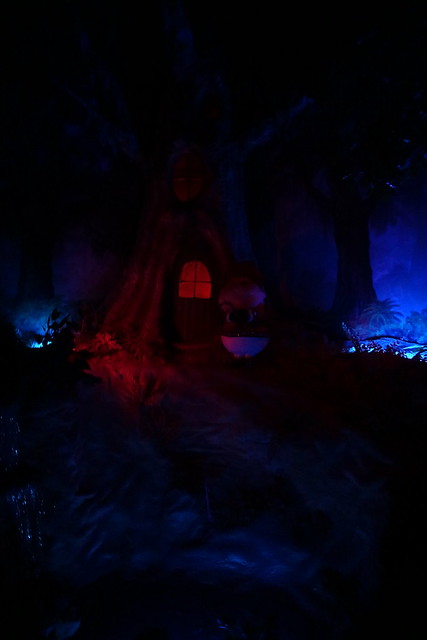 Halfway through the ride we meet this sinister fellow at the end of a long room. He threatens for his guards to capture us, and our vehicle scoots back out the way it came in.
Halfway through the ride we meet this sinister fellow at the end of a long room. He threatens for his guards to capture us, and our vehicle scoots back out the way it came in.
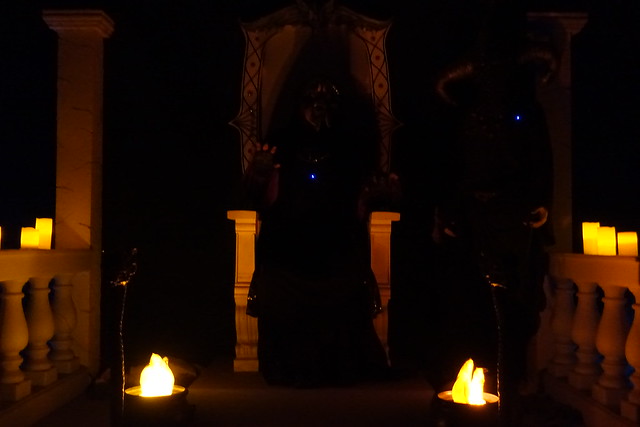
 We spin around by this cool treasure room with a treasure-dwelling kraken lurking in the middle.
We spin around by this cool treasure room with a treasure-dwelling kraken lurking in the middle.
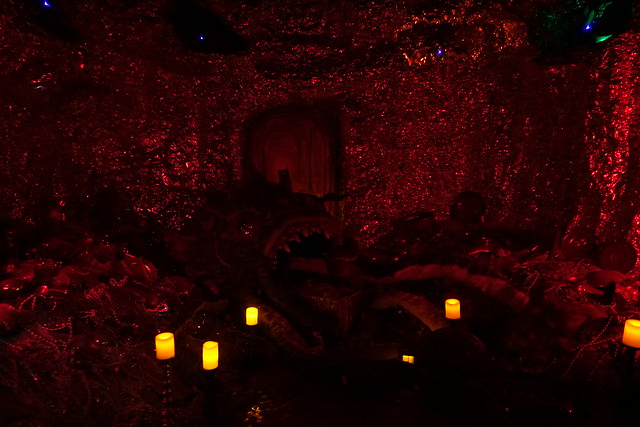 We also meet a few dragons. Apparently the dragons were recently refurbished with new paint and details.
We also meet a few dragons. Apparently the dragons were recently refurbished with new paint and details.
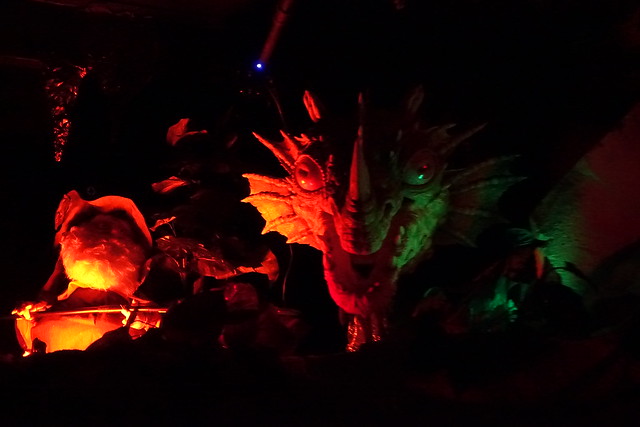
 Scenic backdrops with a high-fantasy flair.
Scenic backdrops with a high-fantasy flair.
 Eventually we end up… somewhere?… and the Drumlins seem to be saved. Unfortunately these last few scenes needed some more attention from a lighting designer.
Eventually we end up… somewhere?… and the Drumlins seem to be saved. Unfortunately these last few scenes needed some more attention from a lighting designer.

 My first ride I was only ten points off from being a Knight and the ride host still declared “aww, you’re just a Knight in Training!”
My first ride I was only ten points off from being a Knight and the ride host still declared “aww, you’re just a Knight in Training!”
 While I couldn’t make sense out of everything that happened, I need to give props to the Challenge of Mondor for being the rare small park dark ride that’s able to choose one story and stick with it to the end. (Although the ability to avoid a random jungle scene towards the end doesn’t necessarily speak well on the state of most other smaller themed attractions.) Check the video for the full ride-through:
While I couldn’t make sense out of everything that happened, I need to give props to the Challenge of Mondor for being the rare small park dark ride that’s able to choose one story and stick with it to the end. (Although the ability to avoid a random jungle scene towards the end doesn’t necessarily speak well on the state of most other smaller themed attractions.) Check the video for the full ride-through:
The second main theme area containing Enchanted Forest’s other two big ticketed attractions is Tofteville, a western frontier town. Perhaps a little removed from the Enchanted Forest uber-theme than either Storybook Lane or Old World Village, but the execution is once again very well done. Like Knott’s Ghost Town, Tofteville has lots of bespoke wooden structures with the right amount of rickety feeling that would be impossible to pull off in today’s corporate parks, and features lifesize dioramas and artifact displays that obviously speak to the creator’s intrinsic fascination with the old west… although perhaps with an even greater sense of humor about the topic than Walter Knott had.


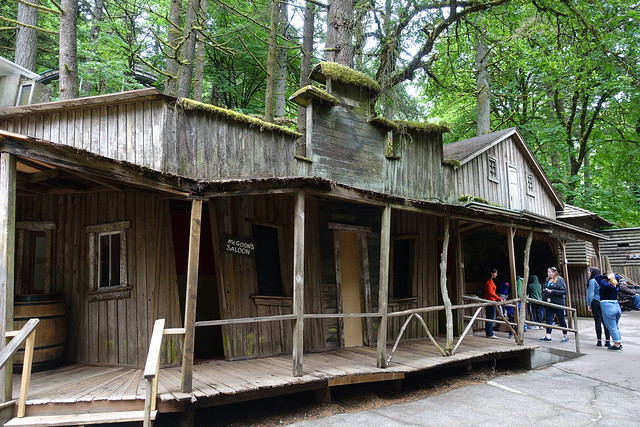
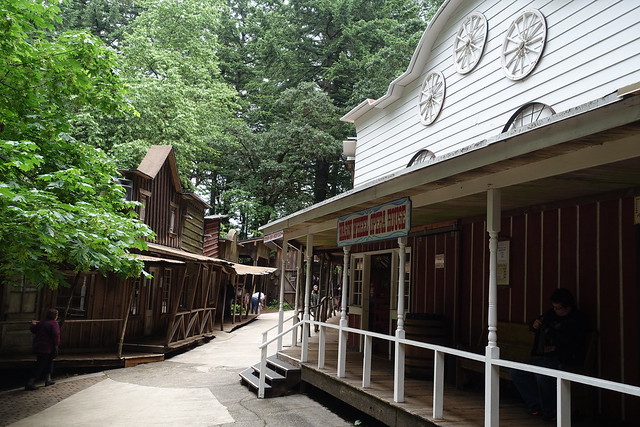


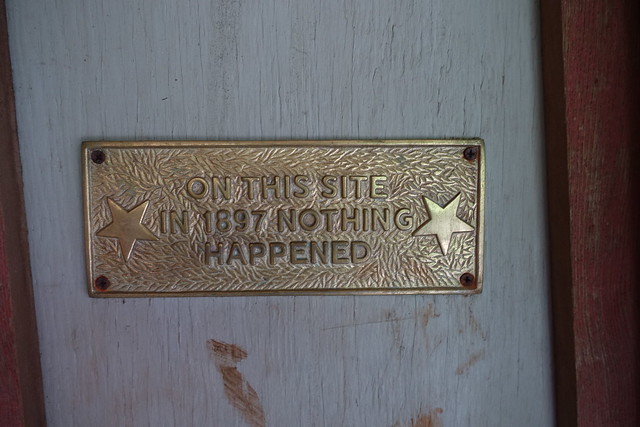
 Just like Old World Village, the land of Tofteville itself is an attraction. Behind this door was a wobbly floor that causes visitors to stumble around like drunks.
Just like Old World Village, the land of Tofteville itself is an attraction. Behind this door was a wobbly floor that causes visitors to stumble around like drunks.
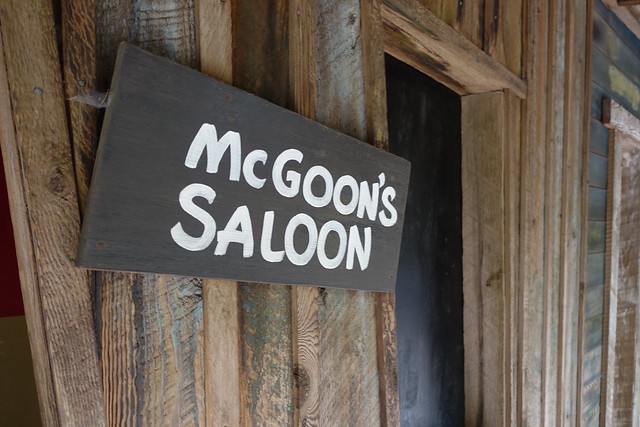 The shooting gallery seemed popular with the local clientele.
The shooting gallery seemed popular with the local clientele.
 There’s also a remote controlled boat pond.
There’s also a remote controlled boat pond.
 Just outside of the main stretch of Tofteville sits the Haunted House, convincingly appearing as if it always existed on the property.
Just outside of the main stretch of Tofteville sits the Haunted House, convincingly appearing as if it always existed on the property.
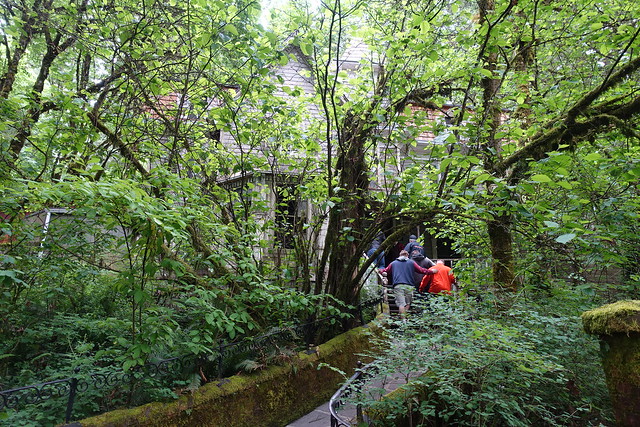

 This walk-through attraction features no live scare-actors, however there are a fair number of classic optical tricks and even a couple jump-scare triggers. Opening in 1974, this is another case where the Disney inspiration is strongly felt. Impressively, they maintain the old Victorian manor aesthetic throughout the majority of the route; I would argue even Disneyland’s Haunted Mansion had a more difficult time picking one architectural style and sticking with it all the way through.
This walk-through attraction features no live scare-actors, however there are a fair number of classic optical tricks and even a couple jump-scare triggers. Opening in 1974, this is another case where the Disney inspiration is strongly felt. Impressively, they maintain the old Victorian manor aesthetic throughout the majority of the route; I would argue even Disneyland’s Haunted Mansion had a more difficult time picking one architectural style and sticking with it all the way through.



 It’s a fairly long experience too, which they let you take at your own pace.
It’s a fairly long experience too, which they let you take at your own pace.
 Projection mapped faces on heads detached from bodies make an appearance here.
Projection mapped faces on heads detached from bodies make an appearance here.
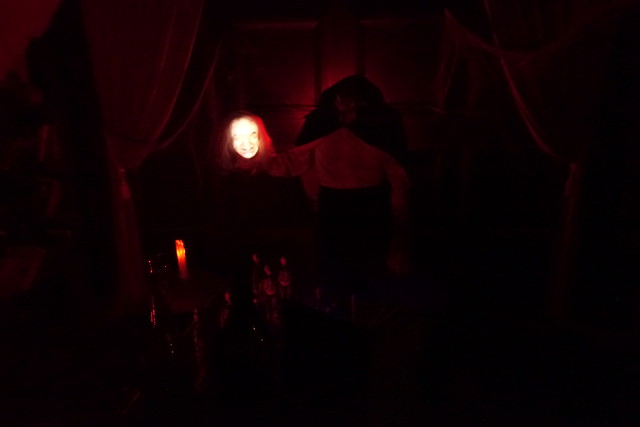 Floating objects in a blacklight room is a technique that works pretty effectively here.
Floating objects in a blacklight room is a technique that works pretty effectively here.
I can’t help but wonder if The Shining was an inspiration for this Pepper’s ghost gag.
But my favorite part, the Haunted House finishes with this pair of adorably spoopy skeletons locked in a dungeon, singing an originally recorded farewell song to guests. (What’s that, a spook house that offers a sense of resolution and doesn’t just randomly end when it runs out of scenes?) Low-fi, but quite possibly my new favorite permanent theme park walk-through attraction!
The last of the four main attractions is found out on the wooded frontier of Tofteville: Big Timber Log Ride. This water coaster hybrid by E&F Miler Industries opened in 1996. Although it lacks an artificial mountain, this ride makes use of the same hillside topography used by the Ice Mountain Bobsled.
They offer free use of a rain poncho in the station. I almost passed on it but decided last minute before climbing in to wear one just in case.
We start with a climb up the side of the hill into the indoor portion of the ride.
At the top there’s a scene of animatronic figures milling timber, much like Knott’s Timber Mountain Log Ride. However, after this point Big Timber very much turns into its own unique experience.
The flume heads out through the woods, passing a few other small scenes. There’s a shorter cascade dip up ahead, by which point I tucked away my camera for the remainder of the ride.
After another brief lift, the log transfers onto a coaster track section for a speedy drop and incline.
After a 90 degree turn, it’s a steep and speedy 40 foot plunge into the pool below.
Good choice to use the poncho, as I would have gotten quite wet on the splashdown!
Big Timber Log Ride has a good mix of different elements in a beautiful setting to create one of the better flume rides I’ve been on. Especially by 1996 standards, Enchanted Forest didn’t have to make their log flume this elaborate, but they took the effort to build an attraction that would have a high re-ridability value and would stand the test of time.
Building a small quantity of uniformly high-quality customized attractions with almost no “filler” is a remarkably rare strategy in the world of theme parks. Perhaps the reason is because it’s a higher risk strategy, and most small parks don’t have a permanent pool of talent or visionary leadership to commit to large custom projects only once a decade. Plus, one drawback from the guest perspective is that for as much as there is to love about this park, I also found I didn’t need as much time here to feel like I had “completed” my visit as I would at a larger theme park or even a ride-centric small park like Oaks Amusement Park. Personally, I respect parks that respect my time, but not everyone might see it that way. Tellingly, the food services here are the park’s weakest link, probably because many families don’t stay long enough to require them to eat a full meal on property, let alone multiple meals. There’s also a corner in the back of the park behind Tofteville that’s loosely carnival themed but really just a collection of off-the-shelf children’s rides, presumably to cheaply satisfy a demand for extra programming the rest of the park can’t provide.
 But then you round the corner and find a well-attended half-hour show at the Comedy Theatre of a delightfully sassy Little Red Riding Hood, and it’s clear that Enchanted Forest both understands its audience and, just as importantly, understands itself. The theater was built so that each season’s new show could be written and directed by Roger Tofte’s daughter who has a passion for theater; like nearly everything else in this park, it shows.
But then you round the corner and find a well-attended half-hour show at the Comedy Theatre of a delightfully sassy Little Red Riding Hood, and it’s clear that Enchanted Forest both understands its audience and, just as importantly, understands itself. The theater was built so that each season’s new show could be written and directed by Roger Tofte’s daughter who has a passion for theater; like nearly everything else in this park, it shows.

 As I was leaving, I realized that I would have to add Enchanted Forest to my list of 19 (now 20) Essential & Very Good Parks from around the world. My previous “first time” visiting a park on that list was in 2012. I hope to be back someday soon.
As I was leaving, I realized that I would have to add Enchanted Forest to my list of 19 (now 20) Essential & Very Good Parks from around the world. My previous “first time” visiting a park on that list was in 2012. I hope to be back someday soon.




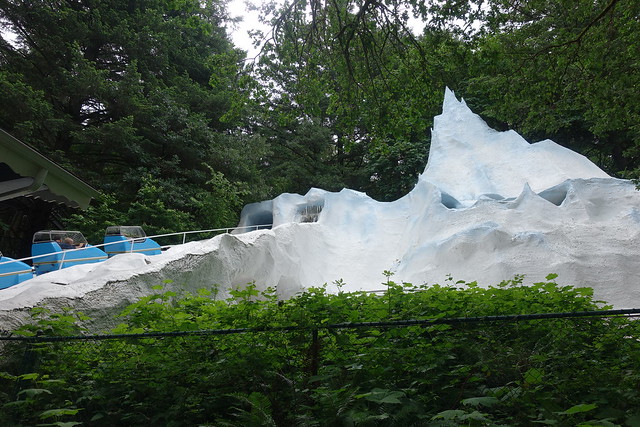



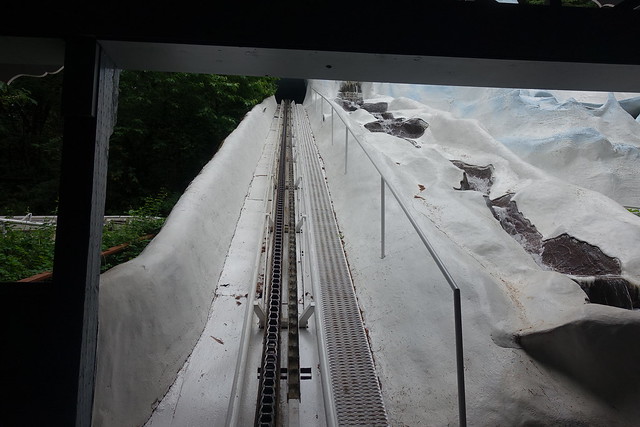


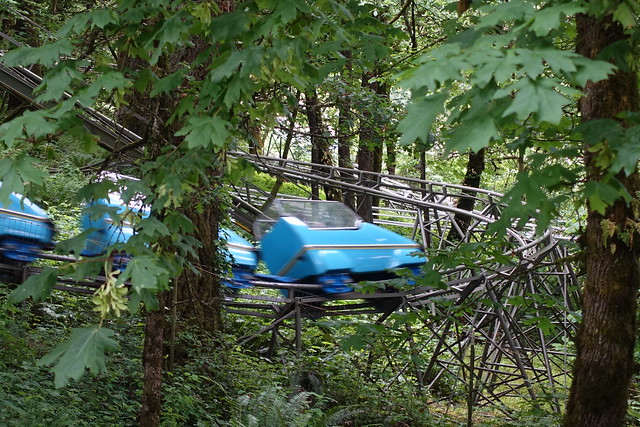


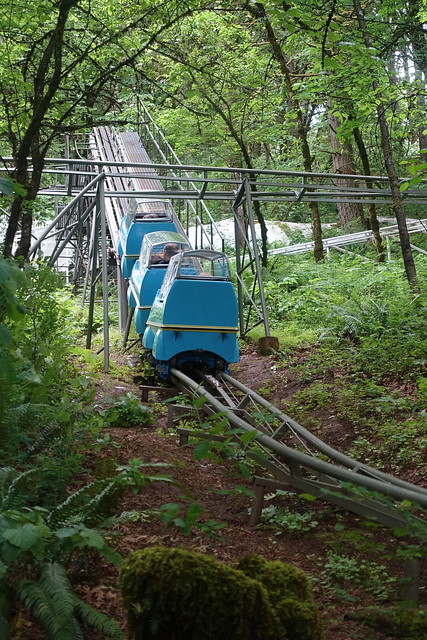



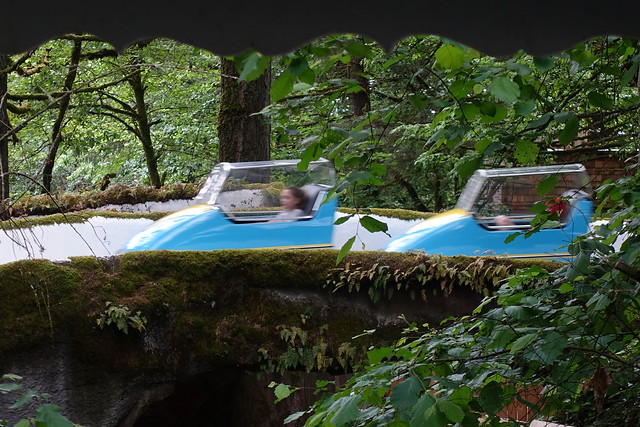


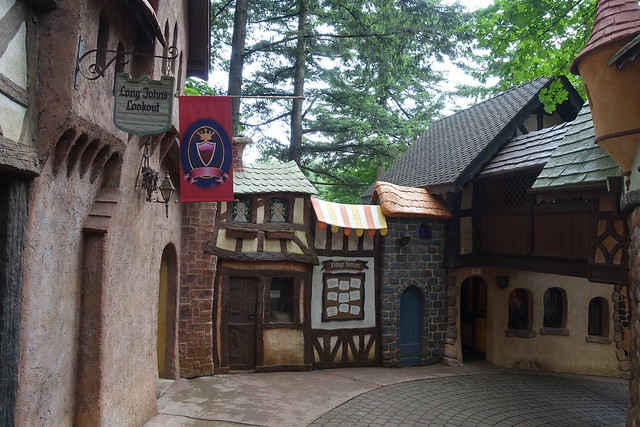





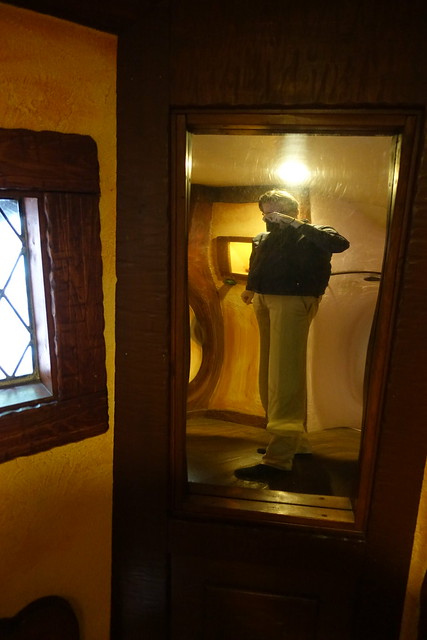














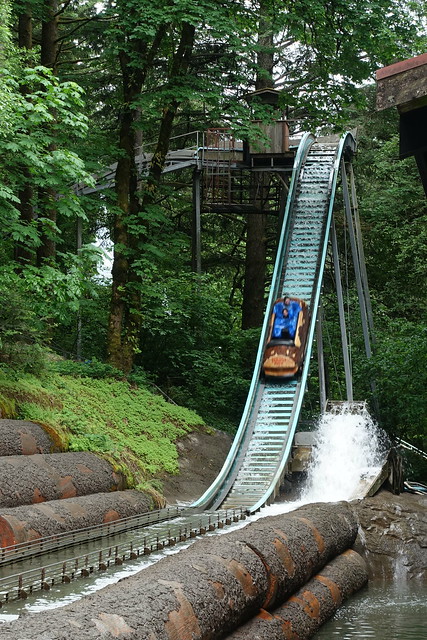




Comments